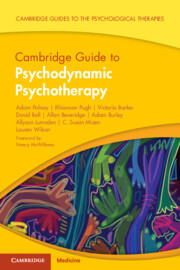Book contents
- Cambridge Guide to Psychodynamic Psychotherapy
- Cambridge Guides to the Psychological Therapies
- Reviews
- Cambridge Guide to Psychodynamic Psychotherapy
- Copyright page
- Dedication
- Contents
- Foreword
- Preface
- A Note from the Series Editor
- Acknowledgements
- Part 1: An Overview of the Model
- Part 2: The Model of Psychodynamic Psychotherapy into Practice
- Part 3: Application for Mental Health Presentations
- Part 4: Application of Psychodynamic Psychotherapy in Different Populations and in Different Settings
- Beyond 1:1 Therapy: Working Psychodynamically with Clinicians, Teams, and Organisations
- Other Forms and Settings of Psychotherapeutic Work
- Chapter 20 A Psychodynamic Approach to Working with People Experiencing Multiple Exclusion Homelessness
- Chapter 21 Psychodynamic Psychotherapy Online and by Phone
- Chapter 22 Group Analysis and its Applications
- Glossary of Terms
- Index
- References
Chapter 20 - A Psychodynamic Approach to Working with People Experiencing Multiple Exclusion Homelessness
from Other Forms and Settings of Psychotherapeutic Work
Published online by Cambridge University Press: 25 August 2023
- Cambridge Guide to Psychodynamic Psychotherapy
- Cambridge Guides to the Psychological Therapies
- Reviews
- Cambridge Guide to Psychodynamic Psychotherapy
- Copyright page
- Dedication
- Contents
- Foreword
- Preface
- A Note from the Series Editor
- Acknowledgements
- Part 1: An Overview of the Model
- Part 2: The Model of Psychodynamic Psychotherapy into Practice
- Part 3: Application for Mental Health Presentations
- Part 4: Application of Psychodynamic Psychotherapy in Different Populations and in Different Settings
- Beyond 1:1 Therapy: Working Psychodynamically with Clinicians, Teams, and Organisations
- Other Forms and Settings of Psychotherapeutic Work
- Chapter 20 A Psychodynamic Approach to Working with People Experiencing Multiple Exclusion Homelessness
- Chapter 21 Psychodynamic Psychotherapy Online and by Phone
- Chapter 22 Group Analysis and its Applications
- Glossary of Terms
- Index
- References
Summary
This chapter provides a brief introduction to the relational dynamics underlying ‘multiple exclusion homelessness’ and an approach to working in this area. Adults experiencing multiple exclusion homelessness have often, during their developmental years, experienced multiple homes, disrupted attachments, un-forecasted endings, multiple and short-lived figures of support – all experiences that can lead a person to develop an understandable anxiety about trusting anyone to remain stable in their life. These dynamics may inadvertently be recreated in the person’s adult life through the impermanency of different organisations they are involved with. Multiple exclusion homelessness can be understood as a late emerging symptom of underlying difficulties in someone’s relationships with care. A psychologically informed approach for staff working in the homeless sector is outlined. The staff-service user relationship, while often viewed as important within mainstream services, is commonly seen as a vehicle through which treatments can be completed rather than as the treatment itself. By contrast, a psychologically informed service for people experiencing multiple exclusion homelessness understands that the reverse is often more accurate: that the tasks and activities are really just the vehicle through which a relationship can develop that carries the possibility of developing a sense of safety, trust, and continuity.
Keywords
- Type
- Chapter
- Information
- Cambridge Guide to Psychodynamic Psychotherapy , pp. 291 - 299Publisher: Cambridge University PressPrint publication year: 2023



